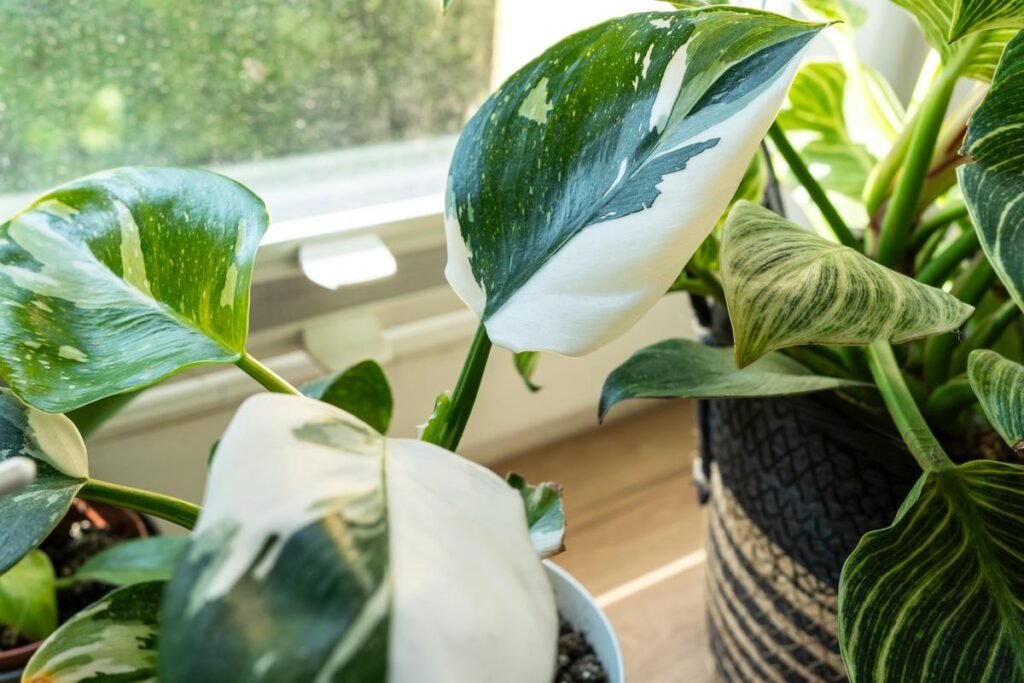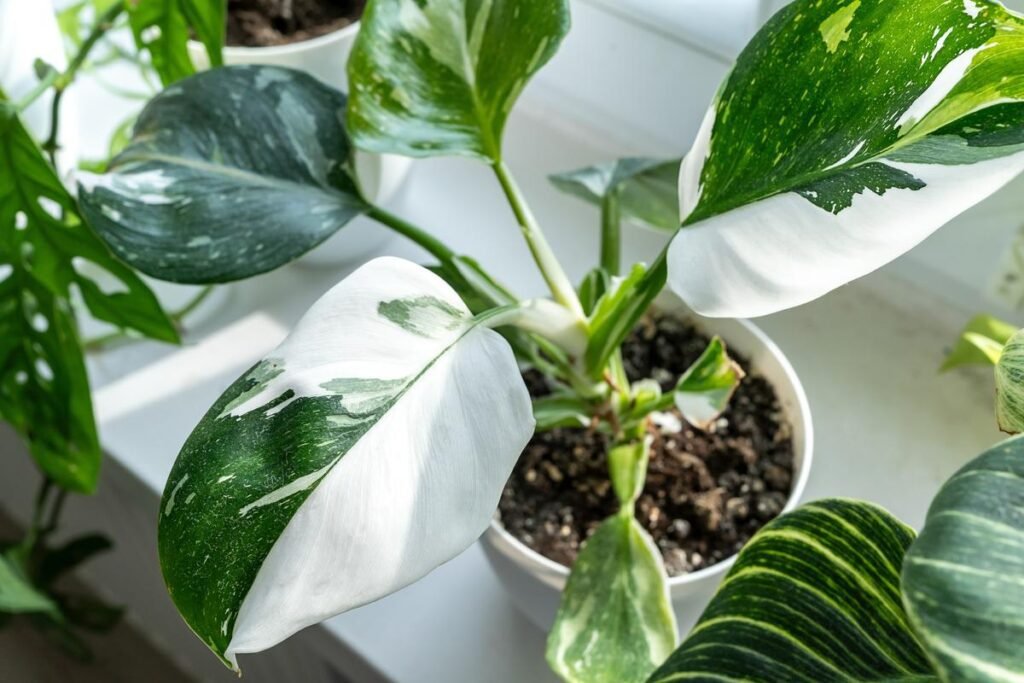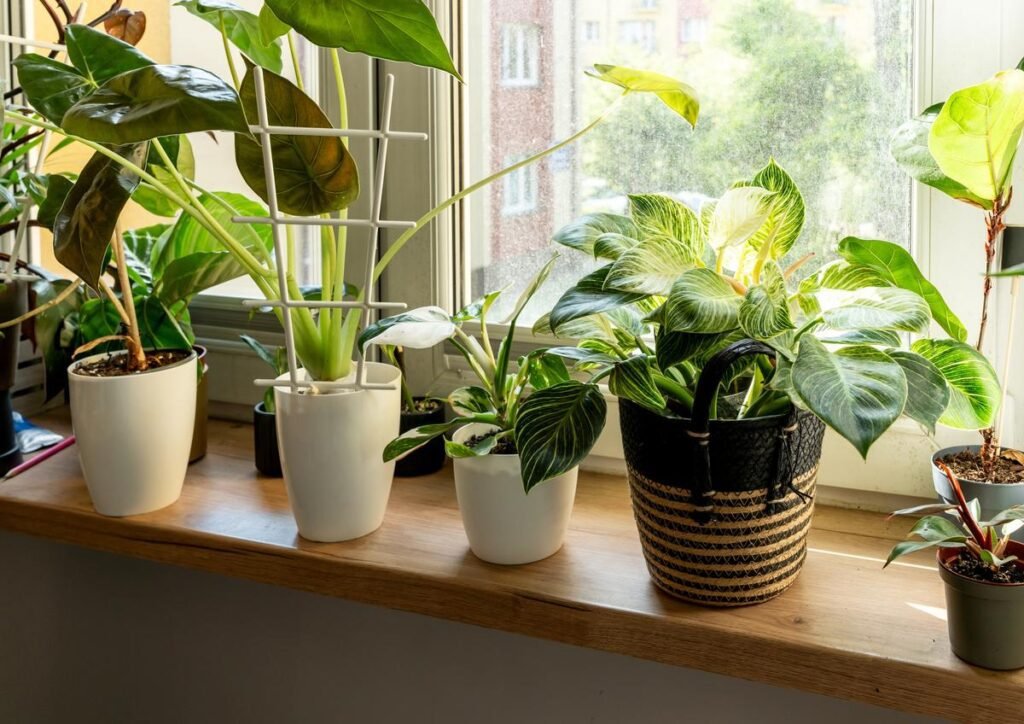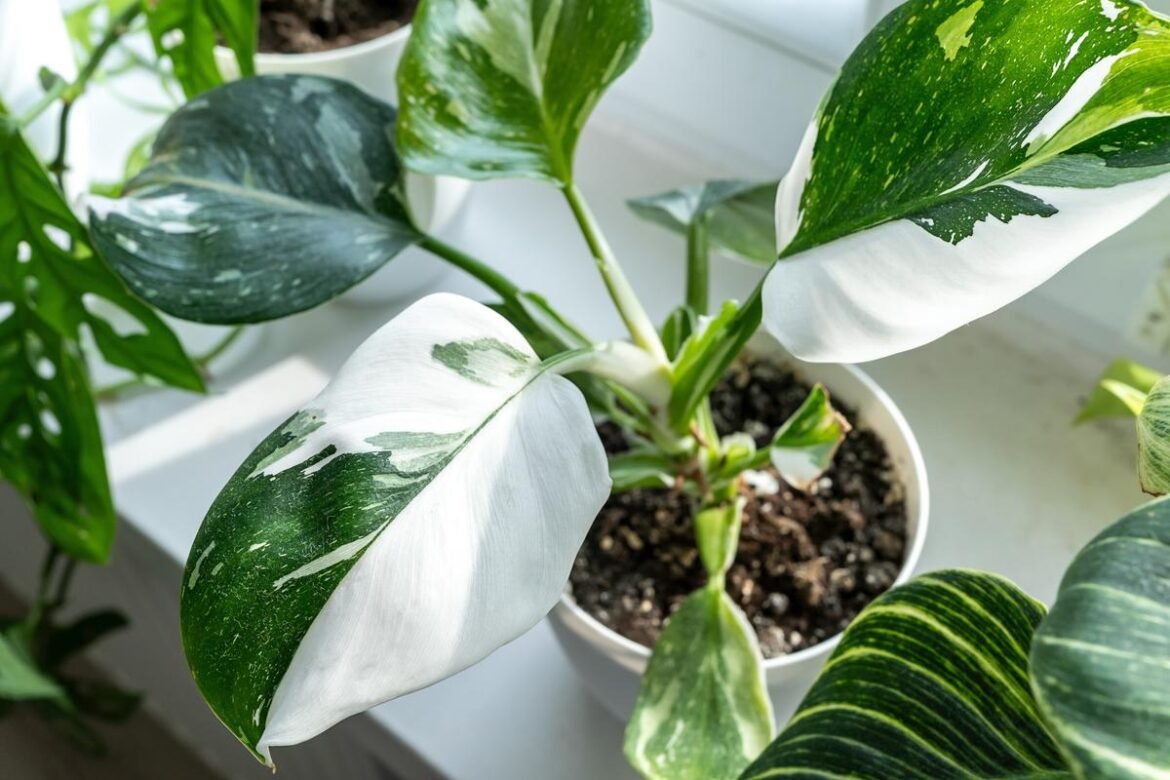Table of Contents
How to Grow White Princess Philodendron: The Ultimate Care Guide
Philodendron White Princess is a stunning houseplant with green and white variegated leaves. It is a rare and sought-after plant that can add a touch of elegance and beauty to any indoor space. However, caring for this plant can be challenging, as it requires specific conditions to thrive and maintain its variegation. In this post, we will guide you through the basics of Philodendron White Princess care, as well as some expert tips and tricks to help you grow a healthy and happy plant.
About Philodendron White Princess
What is a White Princess Philodendron?
Philodendron White Princess is a tropical plant that belongs to the Araceae family, along with other popular houseplants such as Monstera, Alocasia, and Anthurium. It is a self-heading plant, which means it does not climb or vine like some other philodendrons. Instead, it grows upright with a compact and bushy habit.
The most striking feature of Philodendron White Princess is its foliage. The leaves are heart-shaped and glossy, with varying patterns of white variegation. The white parts can range from pure white to cream or pink, depending on the light and temperature. The white variegation is caused by a genetic mutation that prevents the production of chlorophyll in some cells. This makes the plant more sensitive to light and water, as it cannot photosynthesize as efficiently as a fully green plant.
Philodendron White Princess is not a true species, but rather a cultivar or hybrid of unknown origin. It is closely related to Philodendron Pink Princess, another popular variegated philodendron with pink splashes on the leaves. However, Philodendron White Princess is much rarer and harder to find than its pink cousin.
Origins and Unique Features of White Princess Philodendron
| Feature | Description |
|---|---|
| Origins | Native to South American rainforests, it thrives in warm, humid, and shaded environments. |
| Size | In the wild, it can reach 3 feet in height and width, but in cultivation, it’s usually smaller. |
| Roots | Has both underground roots for anchoring and aerial roots for absorbing moisture and nutrients. |
| Attachment | Can attach itself to other plants or structures using its aerial roots for support. |
| Flowers | Produces inflorescences with a spadix and spathe; not showy or fragrant, often hidden by foliage. |
| Pollination | Flowers contain both male and female parts and are pollinated by insects or wind. |
| Spathe Color | The spathe can be green, white, or pink, depending on the specific variety. |
Caring for Your Philodendron White Princess
Philodendron White Princess is not an easy plant to care for, as it has specific requirements for light, water, temperature, humidity, soil, fertilizer, and propagation. If you want to keep your plant healthy and happy, you need to follow these guidelines carefully.

Light Requirements for White Princess Philodendron
| Light Requirement | Description |
|---|---|
| Ideal Light | Bright indirect light is essential for healthy growth and maintaining variegation. Direct sunlight can harm leaves. |
| Avoid Direct Sun | Too much direct sunlight can scorch or fade leaves, potentially damaging the plant. |
| Avoid Low Light | Insufficient light can cause loss of white variegation and make the plant leggy. |
| Ideal Placement | Place near a window with filtered or diffused light all day for the best results. |
| Artificial Light | Fluorescent or LED bulbs can supplement natural light but should be 6 inches away to prevent leaf damage. |
| Rotation | Rotate the plant every few weeks for even growth and exposure to light from different angles. |
Philodendron White Princess needs bright indirect light to grow well and maintain its variegation. Too much direct sunlight can scorch or fade the leaves, while too little light can cause the plant to lose its white parts and become leggy. The ideal spot for your plant is near a window that receives filtered or diffused light throughout the day.
You can also use artificial lights such as fluorescent or LED bulbs to supplement the natural light. However, make sure to keep your plant at least 6 inches away from the light source to avoid burning or bleaching the leaves. You can also rotate your plant every few weeks to ensure even growth and exposure.
Best Watering Practices for White Princess Philodendron
| Factor | How to Do It | Tips |
|---|---|---|
| Soil moisture | Check the top 2 inches of the soil with your finger or a moisture meter | Water only when the soil feels dry |
| Watering method | Water thoroughly and evenly until the water drains out of the drainage holes | Avoid watering only the top layer of the soil or getting water on the leaves or stems |
| Watering frequency | Water once a week in summer and once every two weeks in winter | Adjust according to the weather and the condition of your plant |
| Drainage and humidity | Use a pot with drainage holes and a porous material, and empty the saucer or tray after watering | Use a humidifier or a pebble tray to increase the humidity around your plant |
Philodendron White Princess likes to be kept moist but not soggy. Overwatering or underwatering can cause serious problems for your plant, such as root rot, fungal infections, leaf drop, yellowing, wilting, or loss of variegation. To avoid these issues, you need to water your plant properly and regularly.
The best way to water your plant is to check the soil moisture before watering. You can use your finger or a moisture meter to do this. Insert your finger or the probe into the top 2 inches of the soil and feel how wet or dry it is. If the soil feels dry, it’s time to water your plant. If the soil feels moist or wet, wait until it dries out a bit before watering again.
When you water your plant, make sure to water it thoroughly and evenly, until the water drains out of the drainage holes. Avoid watering only the top layer of the soil, as this can cause uneven moisture and root rot. Also, avoid getting water on the leaves or stems, as this can cause fungal infections or rotting.
After watering your plant, empty the saucer or tray under the pot to prevent waterlogging and root rot. You can also use a pot with drainage holes and a porous material such as terracotta or ceramic to allow excess water to evaporate.
The frequency of watering your plant depends on several factors, such as the size of the pot, the type of soil, the temperature, the humidity, and the season. Generally, you need to water your plant more often in summer than in winter, as the plant transpires more and the soil dries out faster. You can also adjust your watering schedule according to the weather and the condition of your plant.
A good rule of thumb is to water your plant once a week in summer and once every two weeks in winter. However, this is only a general guideline, and you should always check the soil moisture before watering. You can also use a humidifier or a pebble tray to increase the humidity around your plant, as this can reduce the water loss and keep your plant hydrated.
Temperature and Humidity Preferences of White Princess Philodendron
| Factor | Ideal Range | Tips |
|---|---|---|
| Temperature | 65°F to 75°F (18°C to 24°C) | Avoid sudden changes or cold drafts |
| Humidity | 60% to 80% | Use a humidifier, a pebble tray, a misting bottle, or group with other plants |
Philodendron White Princess is a tropical plant that loves warm and humid conditions. It can tolerate a wide range of temperatures, from 55°F to 85°F (13°C to 29°C), but it prefers temperatures between 65°F and 75°F (18°C to 24°C). It does not like sudden changes in temperature or cold drafts, as this can stress or damage the plant.
Philodendron White Princess also enjoys high humidity levels, as this mimics its natural environment. It can survive in low humidity, but it may lose some of its variegation or develop brown edges on the leaves. The ideal humidity level for your plant is between 60% and 80%. You can increase the humidity around your plant by using a humidifier, a pebble tray, a misting bottle, or grouping it with other plants.
The Ideal Soil for Philodendron White Princess
Philodendron White Princess needs well-draining soil that is rich in organic matter and slightly acidic. The soil should retain some moisture but not become soggy or compacted. A good soil mix for your plant is one part peat moss, one part perlite, and one part compost or worm castings. You can also add some bark or charcoal to improve the drainage and aeration.
You should repot your plant every year or two, or when you notice that the roots are growing out of the drainage holes. Choose a pot that is one size larger than the previous one, and make sure it has drainage holes. Fill the pot with fresh soil mix and gently transfer your plant into it. Water your plant well after repotting and place it in a bright spot.
Fertilizing and Propagation of Philodendron White Princess
Philodendron White Princess is not a heavy feeder, but it does benefit from some fertilizer during the growing season. Fertilizer can provide your plant with essential nutrients and boost its growth and variegation.

Feeding Your White Princess: Fertilizer Needs
You can fertilize your Philodendron White Princess once a month from spring to summer, when the plant is actively growing. You can use a balanced liquid fertilizer diluted to half strength, or an organic fertilizer such as fish emulsion or seaweed extract. Avoid using fertilizers that are high in nitrogen, as this can cause excessive green growth and reduce the variegation.
You should stop fertilizing your plant in fall and winter, when the plant goes into dormancy. You should also avoid overfertilizing your plant, as this can cause salt buildup in the soil and damage the roots. If you notice signs of overfertilization, such as yellowing, browning, or curling of the leaves, flush the soil with water to leach out the excess salts.
Propagating Your Philodendron White Princess: A Step-by-Step Guide
Propagating your Philodendron White Princess is a great way to multiply your plant collection or share it with your friends. It is also a fun and rewarding process that allows you to create new plants from your existing one.
The easiest way to propagate your Philodendron White Princess is by stem cuttings. Here are the steps you need to follow:
- Choose a healthy stem with at least one node (a swollen part where leaves and roots grow) and one leaf. Make sure the stem has some white variegation on it.
- Cut the stem below the node using a sharp and sterilized knife or scissors.
- Remove any lower leaves from the cutting, leaving only one or two leaves at the top.
- Dip the cut end of the stem in some rooting hormone (optional) to speed up root formation.
- Prepare a small pot with moist well-draining soil mix or a glass of water.
- Insert the cut end of the stem into the soil or water, making sure the node is covered.
- Place the pot or glass in a bright spot with indirect light and high humidity. You can cover the pot with a plastic bag or a dome to create a mini greenhouse effect.
- Keep the soil or water moist but not soggy, and mist the cutting regularly to prevent it from drying out.
- Wait for roots to develop, which can take from a few weeks to a few months, depending on the conditions and the season.
- Once the roots are about an inch long, you can transplant the cutting into a larger pot with fresh soil mix and care for it as a normal plant.
Philodendron White Princess vs Other Philodendron Varieties
Philodendron White Princess is one of the many varieties of philodendron that are available in the market. Some of the other popular varieties are Philodendron White Knight, Philodendron White Wizard, and Philodendron Pink Princess. These plants have similar care requirements, but they differ in their appearance and rarity.

Comparing White Princess and White Knight Philodendron
Philodendron White Knight is another variegated philodendron that has green and white leaves. However, it has more white variegation than Philodendron White Princess, and it also has some pink or red hues on the stems and petioles (the stalks that connect the leaves to the stems). Philodendron White Knight is also a climbing plant, unlike Philodendron White Princess, which is self-heading. Philodendron White Knight is more rare and expensive than Philodendron White Princess.
Contrasting Philodendron White Princess with White Wizard
Philodendron White Wizard is another variegated philodendron that has green and white leaves. However, it has less white variegation than Philodendron White Princess, and it also has more green stems and petioles. Philodendron White Wizard is also a self-heading plant, like Philodendron White Princess, but it has larger and more elongated leaves. Philodendron White Wizard is less rare and expensive than Philodendron White Princess.
Troubleshooting Philodendron White Princess Issues
Philodendron White Princess is a beautiful but delicate plant that can suffer from various issues if not cared for properly. Some of the common problems that affect this plant are pests, diseases, and environmental stress.
White Princess Philodendron Diseases & Pests
Philodendron White Princess can be attacked by several pests and diseases that can harm its health and appearance. Some of the common pests that infest this plant are spider mites, mealybugs, scale insects, thrips, and aphids. These pests suck the sap from the plant and cause yellowing, curling, wilting, or dropping of the leaves. They can also spread diseases or viruses to the plant.
Some of the common diseases that affect this plant are fungal infections, bacterial infections, root rot, and leaf spot. These diseases can cause discoloration, rotting, or spots on the leaves or stems. They can also weaken or kill the plant.
To prevent or treat pests and diseases on your Philodendron White Princess, you should follow these steps:
- Inspect your plant at regular intervals for any signs of pests or diseases.
- Isolate your plant from other plants if you notice any infestation or infection.
- Use a soft cloth or a cotton swab dipped in alcohol to wipe off any visible pests from the plant.
- Spray your plant with a mild insecticidal soap or neem oil solution to kill any remaining pests or prevent further infestation.
- Prune off any diseased or damaged parts of the plant and dispose of them properly.
- Repot your plant in fresh soil if you suspect root rot or fungal infection in the soil.
- Avoid overwatering or underwatering your plant, as this can make it more susceptible to pests and diseases.
- Provide adequate light and air circulation for your plant, as this can improve its health and resistance.
Common Growing Problems and Solutions for Philodendron White Princess
Philodendron White Princess can also suffer from some growing problems that are caused by improper care or environmental factors. Some of these problems are:
- Loss of variegation: This can happen if your plant does not receive enough light or if it receives too much direct sunlight. To prevent or restore variegation, you should place your plant in a bright spot with indirect light and avoid full sun exposure.
- Legginess: This can happen if your plant does not receive enough light or if it is overcrowded by other plants. To prevent or correct legginess, you should provide adequate light for your plant and prune off any long or weak stems.
- Yellow leaves: This can happen if your plant receives too much water or if it receives too much fertilizer. To prevent or fix yellow leaves, you should water your plant only when the soil is dry and fertilize your plant only during the growing season with a diluted solution.
- Brown edges or tips: This can happen if your plant receives too little water or humidity, or if it is exposed to cold drafts or dry air. To prevent or remedy brown edges or tips, you should water your plant regularly and increase the humidity around it with a humidifier, a pebble tray, or a misting bottle. You should also avoid placing your plant near air vents, heaters, or windows that can cause temperature fluctuations.
- Curling leaves: This can happen if your plant is stressed by pests, diseases, overwatering, underwatering, or temperature changes. To prevent or treat curling leaves, you should identify and address the cause of stress for your plant and provide optimal growing conditions for it.
The Benefits of White Princess Philodendron as a Houseplant
Philodendron White Princess is not only a beautiful plant to look at, but also a beneficial one to have in your home. Here are some of the benefits of this plant:
The Aesthetic Appeal of Indoor Philodendron White Princess
Philodendron White Princess is a stunning plant that can add a splash of color and contrast to any indoor space. Its green and white variegated leaves create a striking visual effect that can brighten up any room. Its compact and bushy habit makes it suitable for small spaces, such as shelves, tables, or desks. Its elegant and exotic appearance makes it a perfect choice for decorating your home or office.
The Benefit of Caring for a Princess Philodendron
Philodendron White Princess is not only a pleasure to look at, but also a pleasure to care for. Caring for this plant can be a rewarding and relaxing hobby that can improve your mood and well-being. Studies have shown that caring for plants can reduce stress, anxiety, depression, and blood pressure. It can also enhance your concentration, memory, creativity, and productivity. Caring for plants can also help you connect with nature and appreciate its beauty and diversity.
Frequently Asked Questions About White Princess Philodendron
How Fast Does Philodendron White Princess Grow?
Philodendron White Princess is a slow to moderate grower, depending on the conditions and the care it receives. It can grow up to 3 feet tall and wide in its native habitat, but it usually stays smaller in cultivation. It can take several years for it to reach its full size.
How Do We Identify White Princess Philodendron?
Philodendron White Princess can be identified by its green and white variegated leaves that are heart-shaped and glossy. It has both underground and aerial roots that help it absorb moisture and nutrients. It is a self-heading plant that grows upright with a compact and bushy habit. It produces inflorescences that consist of a spadix surrounded by a spathe.
How to Stake White Princess Philodendron?
Philodendron White Princess does not need staking, as it is a self-heading plant that does not climb or vine. However, you can stake it if you want to give it some support or shape. You can use a moss pole, a bamboo stake, or a trellis to stake your plant. You can attach the stem or the aerial roots of your plant to the stake with some twine or clips.
Key Takeaways
Philodendron White Princess is a rare and beautiful houseplant that has green and white variegated leaves. It is not an easy plant to care for, as it requires specific conditions to thrive and maintain its variegation.
Key Takeaways
- Provide bright indirect light for your plant and avoid full sun exposure.
- Water your plant only when the soil is dry and avoid overwatering or underwatering.
- Keep your plant in a warm and humid environment and avoid cold drafts or dry air.
- Use well-draining soil that is rich in organic matter and slightly acidic.
- Fertilize your plant once a month during the growing season with a diluted solution.
- Propagate your plant by stem cuttings with at least one node and one leaf.
- Prevent or treat pests and diseases by inspecting your plant regularly and using natural remedies.
- Enjoy the beauty and benefits of your Philodendron White Princess as a houseplant.
I hope you enjoyed reading this post on White Princess Philodendron: Care Guide and Expert Tips. If you have any questions or comments, please feel free to leave them below.
Thank you for reading! 😊


